

Vol. 38 (Nº 54) Year 2017. Page 28
Dmitry NAPOLSKIKH 1
Received: 29/09/2017 • Approved: 30/10/2017
ABSTRACT: Considered the sectoral aspect of the cluster policy in relation to the problem of methods for constructing a clustering model of the Russian regions. The purpose of this study is to research methodological approaches to improve the objectiveness of modeling of the сlusters. Introduced the results of the localization coefficient of consolidated economic activities on the subjects of the Russian Federation. |
RESUMEN: Se consideró el aspecto sectorial de la política de clusters en relación con el problema de los métodos para construir un modelo de agrupamiento de las regiones rusas. El propósito de este estudio es investigar enfoques metodológicos para mejorar la objetividad del modelado de los clusters. Introdujo los resultados del coeficiente de localización de las actividades económicas consolidadas sobre los temas de la Federación de Rusia. |
The process of formation of clusters at the regional level is the consistent implementation of a set of interrelated steps to organize effective economic cooperation between the parties of the regional economic system. The analysis of the Russian practice of clustering regional economic systems revealed a number of trends and patterns of formation and development of clusters.
The formation and development of integrated cluster formations at the regional level is performed with active use of nature resources; moreover, in Russian Federation the processes of formation of the clusters are implemented most effectively in the regions with traditionally prevailing industrial potential (Achenbach, 2012). The development of the clustering process is impossible without formation of the regional mechanisms and institutions of interaction among enterprises of different economic sectors. Meantime, the mandatory condition for development of clusters is the structural diversification of the regional economic system, based on formation of an effective institutional environment to generate and transfer innovative technologies (Boush, Kulikova and Shelkov, 2016). Here, in the process of development of an innovative multicluster, the increase in the number of the economic agents occurs, forming inter-sectoral added value production chains (Kleiner, 2015).
The problem of identifying potential clusters is Important for the development and support of complex economic and mathematical model of clustering of the regional economy, as well as their sectoral differentiation on the basis of the refined economic performance of the region's specialization on certain types of economic activity. Within the solutions to this problem, based on the theoretical results obtained by the author in the study of cluster it was formed and logically ordered set of economic-mathematical methods adequate to modern Russian conditions.
It is proposed to use Localization coefficient (KL) as the base criterion of specialization of the regional economy on certain types of economic activity. Localization coefficient (KL) for certain types of economic activity in the region is the ratio of the proportion of economic activity in the economic structure of the region to the specific gravity of economic activity within the national economic system. Localization coefficient (KL) is calculated by the following formula:

SR – total production in the framework of economic activity in the region;
QR – the volume of gross output in the region;
SN — total production in the framework of activities in the country;
QN – the volume of gross production in the country.
The methodological advantages of Localization coefficient (KL) thought make it possible to simulate the changes in the structure of the inter-sectoral interactions among the economic agents of the cluster.
Based on the data of the Federal State Statistics Service Russian Federation was carried out the calculation of Localization coefficient (KL) values for 83 regions of the Russian Federation with the exception of the Republic of Crimea and the federal city of Sevastopol. The analysis was conducted for the following bigger economic activities:
1) "Agriculture, hunting and forestry";
2) "Fisheries";
3) "Extraction of minerals";
4) "Manufacturing";
5) "Production and distribution of electricity, gas and water";
6) "Hotels and restaurants".
Dynamics of cluster formation in the regions of the Russian Federation is shown in Table 1.
Table 1
Dynamics of clusters formation in the Russian Federation
(Compiled by Registry of clusters of the Russian cluster observatory)

Accordingly, three "waves of clusterization" of the economic space of the Russian regions are singled out the first - 2009-2011, the second - 2011-2013, the third - 2013-2016. These clustering waves are shown in Figure 1 as an overlay of the data of Table 1.
Figure 1
Waves of clustering the economy of Russian regions
(compiled by the author on the basis of the data in Table 1)
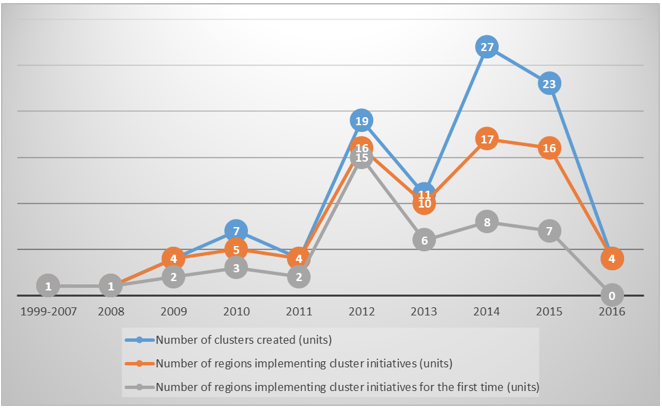
Accordingly, the key task of the study is the development and parametrization of the organizational cluster development, which can become a factor in the generation of the "fourth wave" of clustering Russian regions. At the same time, the insufficient implementation of cluster policy instruments in the development of strategies and programs for regional development impedes the optimal use of the potential of innovative infrastructure facilities. The solution of the problems of economic development and modernization of the old industrial economic systems of the Russian regions actualizes the task of practical implementation of the model of perspective development of cluster initiatives within the framework of the innovation economy.
Consider the value of Localization coefficient (KL) to above of consolidated economic activities by federal districts of Russian Federation. Table 2 shows the value of Localization coefficient (KL) for the Central Federal District of Russian Federation.
Table 2
Values of Localization coefficient (KL) for the
Central Federal District of Russian Federation
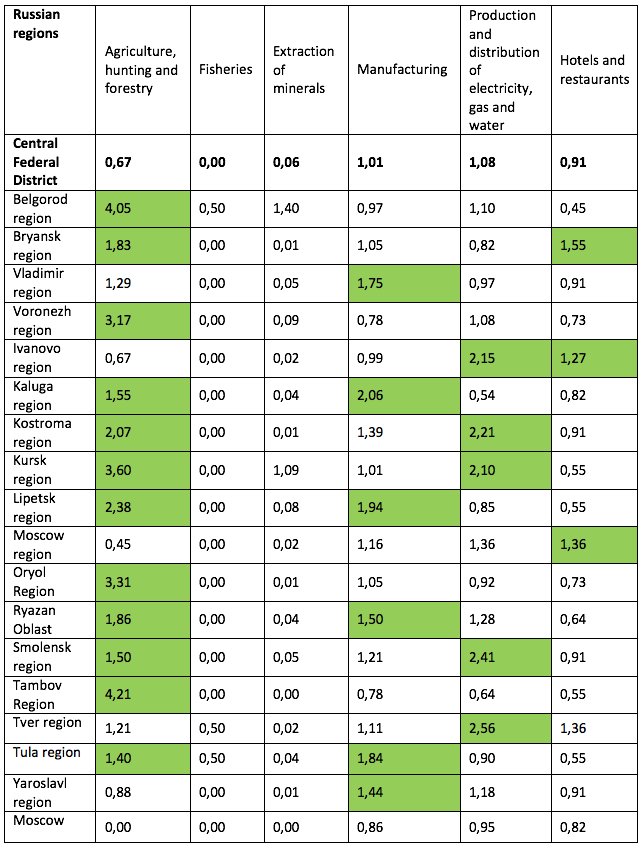
Accordingly, in the Central Federal District has developed the economic potential for clustering of economic systems of its member regions in the following areas:
- creation of natural resource-based multiclusters based on agro-industrial complex;
- the development of regional industrial clusters and innovative c in the Kaluga region.
Table 3 shows the value of Localization coefficient (KL) for the subjects of the North-West Federal District of Russian Federation.
Table 3
Values of Localization coefficient (KL) for the subjects of the North-West Federal District of Russian Federation
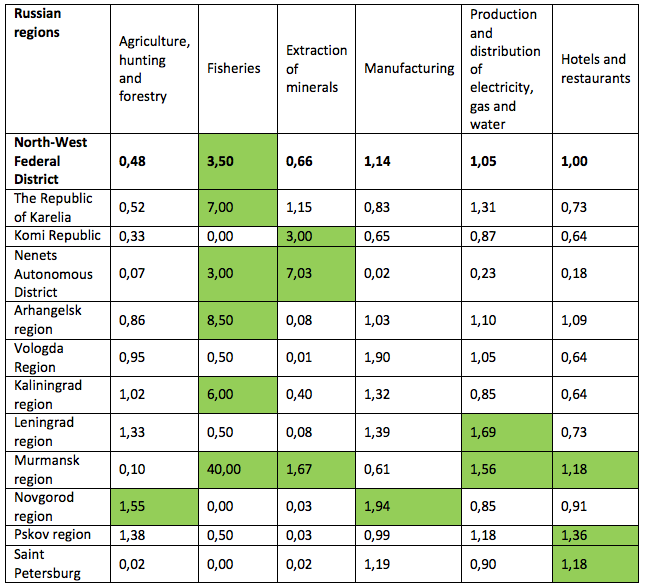
Accordingly, in the North-West Federal District has developed the economic potential for clustering of economic systems of its member regions in the following areas:
- creation of natural resource-based multiclusters in forest management and wood processing areas (Novgorod region) and mining (Komi Republic and the Nenets Autonomous District Murmansk Region);
- formation of innovation and cluster of marine resources;
- the development of regional industrial clusters and innovative multicluster in the Novgorod region.
Table 4 shows the values of the coefficient of Localization coefficient (KL) for the Southern Federal District of Russian Federation.
Table 4
Values of Localization coefficient (KL) for the Southern Federal District of Russian Federation.
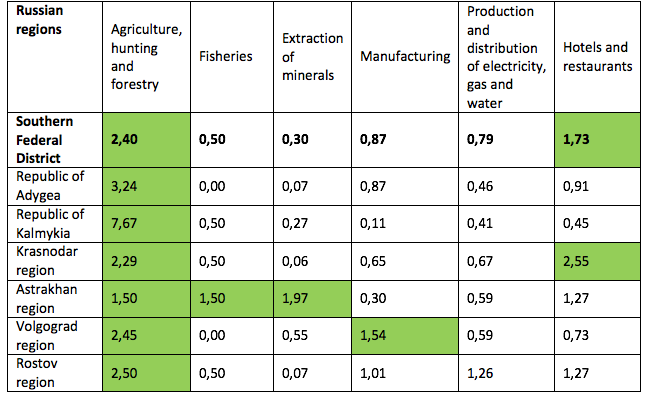
Accordingly, in the Southern Federal District has developed the economic potential for clustering of economic systems of its member regions in the following areas:
- creation of natural resource-based multicluster (Astrakhan region);
- formation of regional industrial cluster in Volgograd Region;
- forming tourism multicluster with the core in the Krasnodar region.
Table 5 shows the values of Localization coefficient (KL) for the North Caucasus Federal District of Russian Federation.
Table 5
Values of Localization coefficient (KL) for the subjects of
the North Caucasus Federal District of Russian Federation
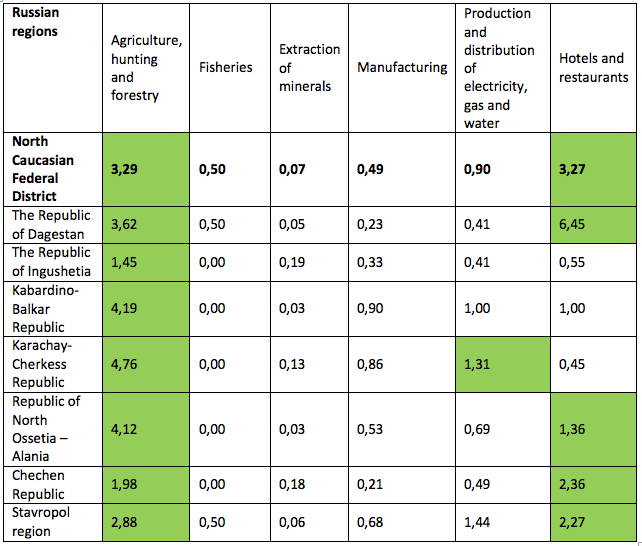
Accordingly, in the North Caucasus Federal District has developed the economic potential for clustering of economic systems of its member regions in the following areas:
- creation of natural resource-based multiclusters;
- forming tourism multiclusters.
Table 6 shows the values of Localization coefficient (KL) for the Volga Federal District of Russian Federation
Table 6
Values of Localization coefficient (KL) for the
Volga Federal District of Russian Federation
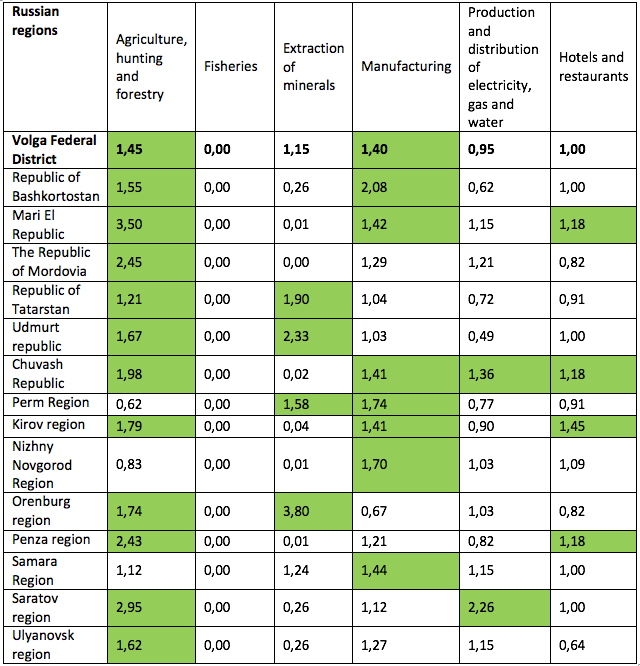
Accordingly, in the Volga Federal District has developed the economic potential for clustering of economic systems of its member regions in the following areas:
- creation of natural resource-based multiclusters in the areas of agriculture, forestry and wood processing and mining;
- the development of regional industrial clusters and innovative multiclusters in the following Russian regions: the Republic of Bashkortostan, the Republic of Mari El, Tatarstan, Chuvashia republic, Perm, Kirov region, Nizhny Novgorod region, Samara region);
- forming tourism multiclusters focused on domestic tourism in the Republic of Mari El, Chuvashia Republic, Kirov region, Penza region.
Table 7 shows the values of Localization coefficient (KL) for the Ural Federal District of Russian Federation.
Table 7
Value of Localization coefficient (KL) for the
Ural Federal District of Russian Federation
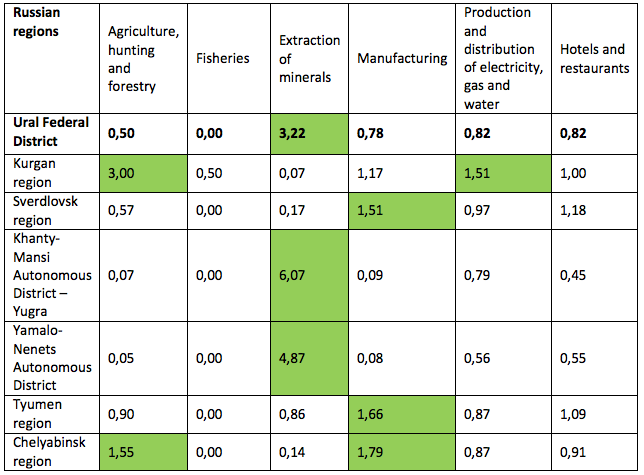
Accordingly, in the Urals Federal District has developed the economic potential for clustering of economic systems of its member regions in the following areas:
- creation of natural resource-based multiclusters in Kurgan and Chelyabinsk regions;
- formation multiclusters subsoil in the Khanty-Mansi and Yamalo-Nenets Autonomous District).
- the development of regional industrial clusters and innovative multiclusters in the following regions of Russia: Sverdlovsk region, Tyumen region, Chelyabinsk region.
Table 8 shows the values of Localization coefficient (KL) for the Siberian Federal District of Russian Federation.
Table 8
Values of Localization coefficient (KL) for the
Siberian Federal District of Russian Federation
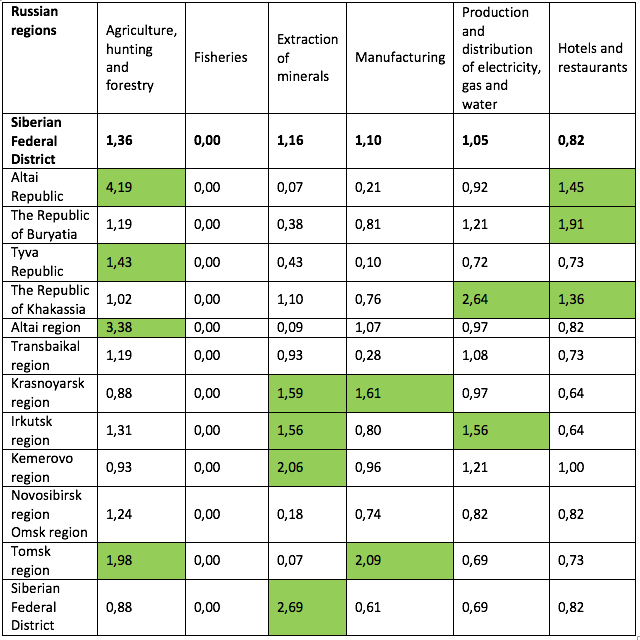
Accordingly, in the Siberian Federal District has developed the economic potential for clustering of economic systems of its member regions in the following areas:
- creation of natural resource-based multiclusters in the areas of agriculture, forestry and wood processing and mining;
- the development of regional industrial clusters and innovative multiclusters in the following regions of Russia: the Krasnoyarsk Territory, the Irkutsk region, Kemerovo region, Tomsk region;
- forming tourism multiclusters focused on domestic tourism in the Republic of Altai, Buryatia, Khakassia.
Table 9 shows the values of Localization coefficient (KL) for the Far Eastern Federal District of Russian Federation.
Table 9
Values of Localization coefficient (KL) for the
Far Eastern Federal District of Russian Federation.
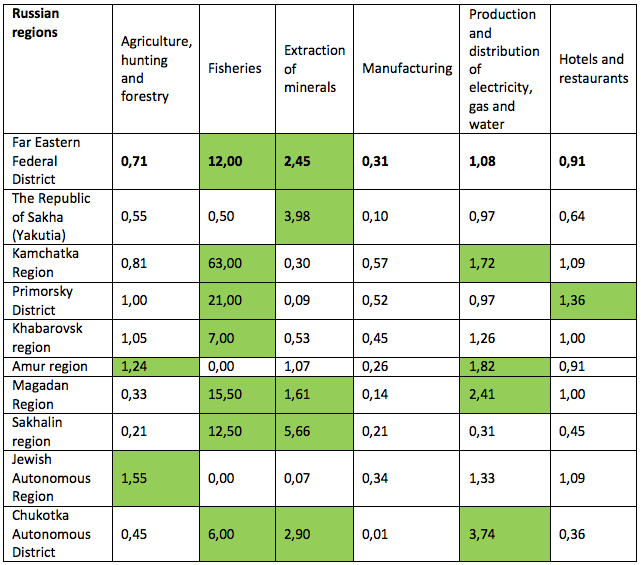
Accordingly, in the Far Eastern Federal District has developed the economic potential for clustering of economic systems of its member regions in the following areas:
- creation of natural resource-based multiclusters in the Amur region and the Jewish Autonomous Region;
- formation of innovation and cluster of marine resources;
- forming tourism multiclusters with the core in the Primorsky region.
The key essential feature of the innovative multiclusters is the complex two-level structure of the cluster-forming "core", acting as the central system-forming element of the inter-sectoral cluster formation and the independent cluster of the innovation type at the same time. The two-level structure of the multicluster core determines the nature of the processes of the integration of the economic agents into the multi-cluster formation (Larionova, Zagaynova and Tarasov, 2015).
The solution to the problem of construction of the dynamic model of the innovative multicluster assumes its consideration as the sectoral organizational structure with the specific elements of the hierarchy and the institutionalization of the interactions (Matafonova, 2016). The previously considered essential features of the innovative multiclusters allow the consideration of the inter-sectoral relationship formed within its framework as relatively homogeneous, equal and mutually beneficial (Porter and Ketels, 2015).
However, the complex economic structure of the multicluster formation presupposes the existence of two overlapping levels of the network interactions. The first (cluster) level includes the network interconnections, formed within the individual sectoral segments of the multicluster based on the implementation of the related activities and processes by the economic agents (Hopf and Tularam, 2014). The second (multicluster) level of the interactions is represented by the economic relations arising among the diverse economic subjects, belonging to different segments of the multicluster (Dzhindzholia, Popkova and Shakhovskaya, 2015).
The specific nature of the hierarchization and institutionalization within the network structure of the multicluster lies in the leading role of the cluster-forming components: the core of the multicluster formation (the innovation cluster as it is) and the organizations, being the formal/informal leaders within the industry segments of the multicluster and influencing the development of the segment as a whole. The unity and the interrelation of the segments of the innovative multicluster are ensured by the flows of the resources of various types, optimally distributed within the multicluster formation among the sectoral segments (Kim et al., 2014).
Based on the values of Localization coefficient conducted the analysis of the potential economic systems of the Russian regions to intensify the processes of clustering and innovative development. Scientifically justified systematization of the main directions of the clustering of economic systems of the Russian regions, depending on their specialization in the following bigger types of economic activities:
1 "Agriculture, hunting and forestry", which represent the main areas of environmental management and creating the basis for the formation of natural resource-based multiclusters;
2. "Fisheries", which have special characteristics and in the coastal regions of the Russian Federation;
3. "Mining", which forms the raw material profile of a number of Russian regions and updated formation for production processing of raw materials, as well as technologies for the rational subsoil;
4. "Manufacturing", which are the basis of economic growth of the national economy and the main consumers of innovative technologies;
5. "Production and distribution of electricity, gas and water", forming the basis for the energy of the "new industrialization" of economic systems of the Russian regions within the framework of import substitution policies;
6. "Hotels and restaurants", forming the potential of domestic tourism development in the Russian regions and the development of tourism clusters.
This researchers was supported by the Grant of the President of the Russian Federation for the state support of young Russian scientists MK-1479.2017.6
Achenbach, Y.A. (2012). Modelling of the mechanism of interaction among the subjects of the regional economy based on the concept of formation and development of the scientific and industrial clusters. FES: Finance. Economy. Strategy, 11(62), 17-23.
Boush, G.D., Kulikova, O.M. Shelkov, I.K. (2016). Agent modelling of cluster formation in regional economic system. The region's economy, 12, 64-77.
Dzhindzholia, A., Popkova, E., Shakhovskaya, L. (2015). Cluster as an Innovational and Organizational Form of State Regulation of Business. American Journal of Applied Sciences, 12, 814-819.
Hopf, C.G.L., Tularam, G.A. (2014). A mathematical analysis of the inclusion of institutional betting funds into stock market: The case of technical and fundamental payoff models in horserace betting. Journal of Mathematics and Statistics, 10, 390-400.
Kim, Y.D., Yoon, S., Kim, H.G. (2014). An economic perspective and policy implication for social enterprise. American Journal of Applied Sciences, 11: 406-413.
Kleiner, G.B. (2015). Strategic planning and enterprise development. Plenary presentations and materials of the Round Table. Fifteenth All-Russian symposium, 16-23
Larionova, N.I., Zagaynova, N.L, Tarasov, V.L. (2015). Institutionalization of concessionary relations: Theory and practice. Vestnik of Volga State University of Technology. Economics and Management, 1(25), 26-37
Matafonova, Yu.A. (2016). Systematic Interpretation of the Factors of Federal Sustainability and Socio-Political Security of a Constituent State of a Federation. American Journal of Applied Sciences, 13, 222-229.
Porter, M., Ketels C. (2015). Cluster Mapping and Cluster-Based Economic Development. Boston: US–EU Cluster Workshop.
1. Department of management and law, Volga state university of technology, Yoshkar-Ola, Russia. Contact e-mail: napolskihdl@yandex.ru